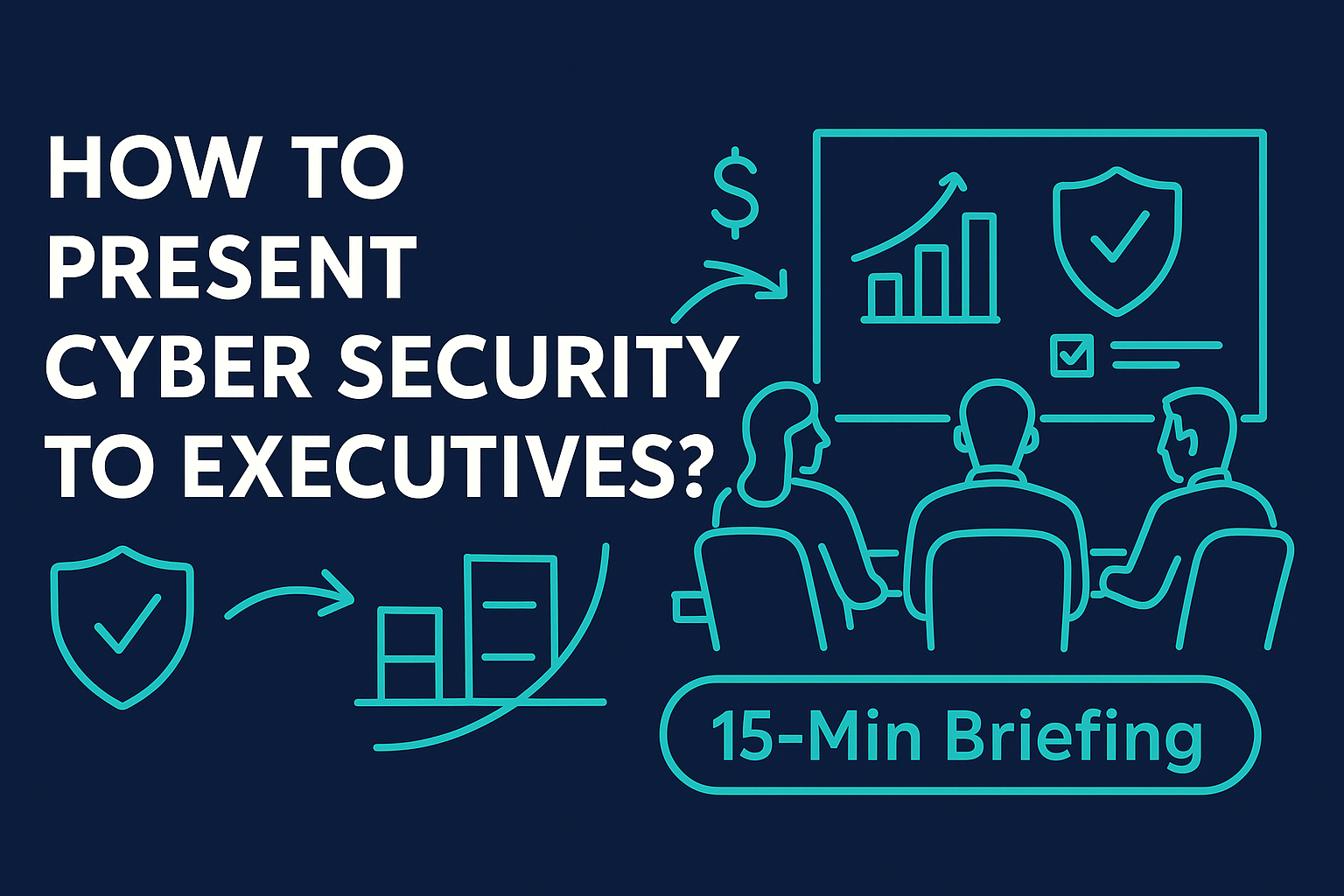How to Present Cyber Security to Executives
Lead with the business, not the breach. In 15 minutes: state the objective, show three outcome KPIs, quantify top risks in dollars, present two options with trade-offs, recommend one, and ask for a decision, budget, or unblock.
Free resource: Want to reach the top of your range faster? Download The Ultimate Guide to Cyber Security Leadership Certifications and pass résumé filters that unlock higher pay bands.
Download the Guide →
The Executive Brief Formula (STEER)
Use this for every deck, memo, or hallway conversation.
Situation – one sentence of context
Target – the business outcome or KPI threshold
Exposure – what’s at risk (impact/likelihood in $$ or customer/ops terms)
Expected options – 2–3 viable paths with costs + trade-offs
Recommendation – one clear ask (budget, headcount, policy, timeline)
If your slide or sentence doesn’t support STEER, cut it.
The 15-minute Meeting Flow
Minute 0–2: Executive summary
“We’re on track on 2/3 key outcomes. One risk needs a decision today.”
Place a single traffic-light scorecard.
Minute 3–6: KPI outcomes
Patch SLA, phishing failure rate, and incident MTTR (or your top three).
Show trend lines and business impact: uptime, audit status, cost avoided.
Minute 7–10: One big risk in dollars
“Legacy payroll server lacks MFA; annualized loss exposure ≈ $2.1M.”
Two options with cost/benefit and time to mitigate.
Minute 11–13: Recommendation & plan
“Approve $180k for conditional access + decommission timeline; cuts 80% of exposure in 60 days.”
Minute 14–15: Decision & next steps
Confirm owner, date, and communication plan. Book follow-up.
Multi Page Slide Outline
Exec summary (STEER) – 60–90 seconds.
Outcome KPIs – trends vs. thresholds; one sentence per chart.
Risk scenario in $$ – simple diagram + ALE math.
Options & trade-offs – 2–3 boxes; cost, time, residual risk.
Recommendation & plan – owners, milestones, dependencies.
Budget & resourcing – one table; capex/opex, FTEs, vendor.
Decisions needed – checkbox list; green when approved.
One-slide Executive Summary Template
Objective: Cut high-risk incidents and audit findings while enabling faster releases.
KPI Today → Target (Q/Q Trend)
• Patch SLA (Critical >30d): 42% → ≤10% (↘ steady)
• Phish failure rate: 3.6% → ≤1.5% (↘ sharp)
• MTTR (P1 incidents): 7.8h → ≤4h (— flat)
Top Risk (ALE ≈ $2.1M): Legacy payroll app lacks MFA / exposure to credential stuffing.
Options:
A) Enforce conditional access + app modernize ($180k, 60 days) – cuts ~80% exposure.
B) Compensating controls only ($40k, 30 days) – cuts ~35%, residual high.
Recommendation: Choose A. Ask: Approve $180k capex + 0.5 FTE backfill; Legal review for vendor SSO clause.
The KPI Set That Resonates With Boards
Pick three that tie directly to your current strategy:
Patch SLA (critical >30 days) – resilience trend
Phishing failure rate – human risk
MFA coverage – account takeover risk
Mean Time to Detect/Respond (MTTD/MTTR) – operational readiness
Third-party criticals with owners & due dates – supply-chain risk
% Crown-jewel apps with documented owners – accountability
Tip: Add a threshold to each KPI (e.g., ≤1.5% phish failure) so red/green is unambiguous.
FAIR-lite: Quantify Risk Easily
Translate risk to cost with a simple, defensible estimate:
Identify scenario: Stolen credentials → payroll fraud.
Estimate frequency: Once every ~2 years (0.5/yr).
Loss magnitude: Direct loss $600k + response/overtime $150k + reputational churn $350k ≈ $1.1M.
Annualized Loss Exposure (ALE): 0.5 × $1.1M = $550k/yr.
Control effect: MFA reduces likelihood 80% → residual ALE ≈ $110k/yr.
ROI framing: Spend $180k once to avoid ~$440k/yr expected loss.
Round numbers, show assumptions, and invite challenge. This method earns trust.
Email Template
Subject: Decision needed: Payroll MFA (cuts ~80% exposure in 60 days)
Body:
Attaching a one-page brief for Monday’s 10:00. Our payroll app lacks MFA; estimated exposure ≈ $550k/yr. Two options enclosed. I recommend Conditional Access + modernization ($180k, 60d). Decision and budget approval requested. Happy to adjust if there are concerns about UX or vendor terms.
Frequently Asked Questions
How long should the deck be?
Seven slides is plenty. If you need more, move details to Appendix or Pre-read.
What if I don’t have exact dollar risk?
Use ranges and note assumptions. Precision is less important than comparative clarity.
How often should I brief?
Monthly is typical for metrics; ad-hoc for decisions. Keep it 15 minutes and predictable.
Next Step
If your goal is to earn top-of-band, combine proof of business impact with the right credential for your target seat.
Bookmark this post, share it with your team, and, most importantly, download the guide so you can take action on the path that propels you from practitioner to cyber security leader.


